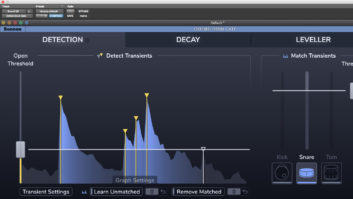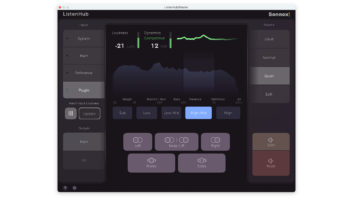Sonnox Oxford plug-ins have a reputation for quality, so when I learned about the Oxford Drum Gate ($169) at AES, I had pretty high expectations. After seeing a demo at the show, and then trying out the plug-in in my studio, I can report that my expectations have been met, and then some.
One of the reasons I’m excited about this product is because I’ve always found it challenging to get useful gate settings when mixing multitrack drums. Often, it seems like it comes down to a choice between letting too much bleed in or, if you get rid of the bleed, having to live with less-than-natural-sounding decays. Oxford Drum Gate, which features an intelligent detection algorithm that can distinguish between snares, kicks, toms and cymbals, makes it much easier to get natural-sounding settings with little or no bleed than you can from a conventional gate.
Oxford Drum Gate is divided into three sections: Detection, Decay and Leveller. In the former, an excellent real-time display shows you the waveforms, giving you a visual target for graphically setting the Threshold, which is represented by a horizontal line that you move vertically.
On the right is the Match Transients section, where you can bring the plug-in’s artificial intelligence to bear. Three buttons, Kick, Snare, and Tom, let you specify the drum type, and you have another Threshold control for Match Transients. Oxford Drum Gate will look for transients from the kind of drum you specified.
Read More Product of the Week: Clair Brothers C10-TrueFit Line Array Loudspeaker.
If there are hits on your track that are not getting matched (and thus not getting through the gate), you can use an additional detection feature called Learn Unmatched, which offers a way to adjust the plug-in’s detection so it will recognize your unmatched hits.
The Decay section lets you set a threshold and a Resonant Decay frequency range. The spectral display enables you to see where the note is decaying. That’s very helpful for setting the range so that the gate allows enough decay time in that area for the drum hit to ring through. You also can turn on the Shorten Decay feature, which will automatically set the decay time based on the transient levels.
The Gain Reduction slider lets you set the gain reduction for the gated audio. It’s handy for controlling the amount of bleed that’s audible.
The final section, Leveller, lets you even out the levels of the transients going to the output, should you want to. It also allows you to specify level targets for both Loud and Soft hits and can be used to control the dynamics of your track and add consistency.
Global controls for Bypass and Output Trim are visible from any of the three sections, as is the MIDI Out section. The latter lets you set a MIDI output note for a track, making it possible to send MIDI out to an external instrument to layer or replace the drum in question.
Alternatively, you can use a button called Capture that turns the audible transients, the ones that are getting through the gate, into a MIDI track. Then you can drag and drop it right into your DAW.
Sonnox has clearly put a lot of thought into the Oxford Drum Gate. The plug-in offers a unique level of performance and user control and is sure to become widely used.







